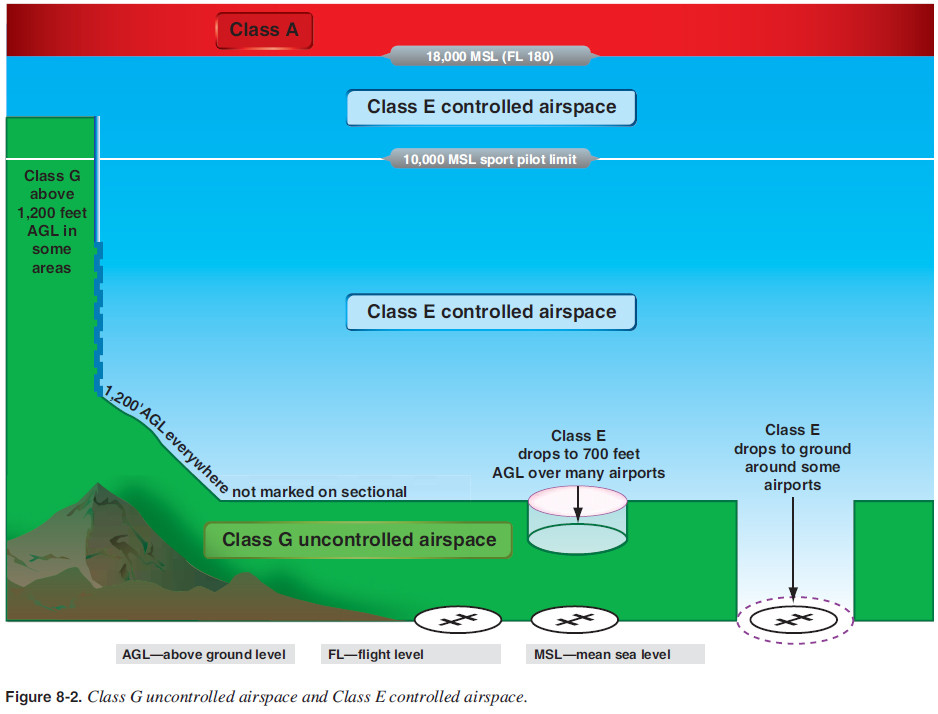I'd like to clarify a very specific statement from 14 CFR Part 103:
103.17 OPERATIONS IN CERTAIN AIRSPACE No Person may operate an ultralight vehicle within Class A, Class B, Class C, or Class D airspace or within the lateral boundaries of the surface area of Class E airspace designated for an airport unless that person has prior authorization from the ATC facility having jurisdiction over that airspace.
The specific statement I need help with is:
or within the lateral boundaries of the surface area of Class E airspace designated for an airport
As we know, Class E airspace can start at the surface (shown as a dashed magenta line on sectional charts), start at 700' AGL (shown as a magenta border), start at 1,200' AGL (shown as a blue border), or start at 14,500 MSL.
In the Aeronautical Information Manual (AIM), the following relevant information is given about Class E airspace under section 3-2-6:
e. Functions of Class E Airspace. Class E airspace may be designated for the following purposes:
- Surface area designated for an airport where a control tower is not in operation. Class E surface areas extend upward from the surface to a designated altitude, or to the adjacent or overlying controlled airspace. The airspace will be configured to contain all instrument procedures.
(a) To qualify for a Class E surface area, the airport must have weather observation and reporting capability, and communications capability must exist with aircraft down to the runway surface.
(b) A Class E surface area may also be designated to accommodate part-time operations at a Class C or Class D airspace location (for example, those periods when the control tower is not in operation).
(c) Pilots should refer to the airport page in the applicable Chart Supplement U.S. for surface area status information.
- Extension to a surface area. Class E airspace may be designated as extensions to Class B, Class C, Class D, and Class E surface areas. Class E airspace extensions begin at the surface and extend up to the overlying controlled airspace. The extensions provide controlled airspace to contain standard instrument approach procedures without imposing a communications requirement on pilots operating under VFR. Surface area arrival extensions become part of the surface area and are in effect during the same times as the surface area.
Part 103 states "or within the lateral boundaries of the surface area of Class E airspace designated for an airport".
That statement has two parts I need help with:
within the lateral boundaries of
and
the surface area of Class E airspace designated for an airport
When looking at a sectional and reading the relevant section of the AIM, what exactly applies to part 103?
I've seen a few attempts to answer the following questions in other forums and it always ends up in a debate including conflicting info from pilots and even FSDO personnel. Is there a clear, definitive "aviation lawyer" legal type answer to the following questions (I'm not concerned with any "should" type discussions here)?
Question 1:
What exactly is the surface area of Class E airspace designated for an airport? Is it any dashed magenta area on a sectional or is it something more specific or different?
Question 2:
And does the within the lateral boundaries of part mean there is no ceiling (meaning an ultralight can't overfly these areas at any altitude) or something else?
For example (for Q3&4), BLYTHE (BLH) (Phoenix sectional) airport:
Question 3:
Can an ultralight fly within the dashed magenta circle? Is this an example of a "surface area of Class E airspace designated for an airport"?
Question 4:
If this is true, what is the ceiling that affects ultralight aircraft? Is it the 700' AGL Class E airspace above the airport? Or does it go all the way up to FL180? In other words, can an ultralight overfly this airport as long as it flies more than 700' AGL?
And what about (for Q5&6) Yuma (NYL) (Phoenix sectional) airport:
Question 5:
Can an ultralight fly within the two Class E extensions to the Class D airport? Or are these two extensions still considered "surface areas of Class E airspace designated for an airport" (and this has the same answer as question 1 above)?
Question 6:
If an ultralight can't fly within these two Class E extensions, can an ultralight flow over these extensions? Is the ceiling 2,700' MSL (same as the Class D airspace of the airport) or is the ceiling 700' AGL (due to the overlying Class E airspace in the area)? Or does it go to FL180 (which would make no sense since an ultralight can overfly the Class D airspace)?




